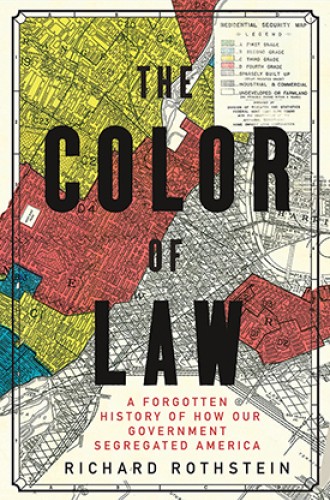Racist public policy and its intended consequences
Segregation isn't just about white flight and redlining. It's about what government does and doesn't do.
The law has never been blind. In fact, when it comes to race and segregation, the law has often done more harm to African American residential communities than racist customs and traditions have. And it has done so intentionally. Richard Rothstein, an expert on race, education, and social policy at the Economic Policy Institute, details what the African American community has always known about residential segregation, shoddy housing and schools, and lack of meaningful job opportunities. He reveals how the consequences of residential segregation from the 1920s to today have been legal, intentional, and long-lasting.
In the preface, Rothstein refers to the riots in Ferguson and Baltimore and quickly disabuses readers of the idea that the causes are solely de facto segregation, meaning private practices like white flight and redlining. The segregation in these cities, he states, is not unintended. It’s the result of intentional government action, law, and policy—in other words, de jure segregation.
Read our latest issue or browse back issues.
Public housing to ease the housing crisis for workers during World War II was unavailable to African American workers, who had to commute long distances to war industry jobs that paid them less than their white counterparts. In the decades after the war, lower- income white people moved up into the middle class and middle-class whites quickly outpaced African Americans, who were still struggling under Jim Crow. The suburbs laid down the welcome mat to white families—who built walls, burned crosses, and threw bricks through the windows of those African Americans foolish enough to think that the American Dream was meant for them.
Eventually discrimination became illegal. But deed restrictions, home loan refusals, installment plans with harsh penalties for being late or missing a payment, and pricing African Americans out of white middle-class neighborhoods continued to accomplish what outright racism could not.
Rothstein argues that these actions were possible only because the government did not enforce antidiscrimination laws in neighborhoods, schools, or unions and refused to quell violence against African Americans who attempted to break down color barriers. These practices created economically and educationally depressed neighborhoods that are nearly impossible to escape, as well as a massive wealth gap between African Americans and white Americans.
Rothstein’s prose is lean. He has no need to embellish an already tragic narrative. Although fact-filled and detailed, The Color of Law is never dry or dull. The text is interspersed with stories of those directly impacted by residential segregation. Pictures include a resigned woman sitting at the curb with her belongings, Mayor Chuck Hall sending a wrecking ball into an African American neighborhood in downtown Miami in 1970, and a 1943 photograph of Joseph James and other African American men who refused to pay dues to a segregated auxiliary union.
The Color of Law is more than a history of de jure and de facto policies that segregated and undermined the economic progress of a people: it’s also a reckoning. The trail of institutional inequities through the decades that Rothstein traces undermines the bootstrap myth that many white Americans have of themselves and their ancestors.
If we want to be a constitutional democracy, Rothstein contends, we must find ways to remedy de facto segregation. It is up to the people who benefit from these disparities in income, housing, education, and access to rectify the system in which others suffer. Rothstein anticipates pushback from people uncomfortable with the truth of our nation’s racist history and those who try to excuse or justify it. The “Frequently Asked Questions” in the appendix address objections that he consistently receives.
St. Louis recently experienced civil disruptions after the verdict on the 2011 killing of 24-year-old African American Anthony Smith and the alleged cover-up by police officer Jason Stockley. Thousands of miles to the east, in Haymarket, Virginia, an African American enclave that grew up on land purchased in 1866 by a former slave, Lavinia Johnson, has been seized by the state to make way for towers that will provide power for a new Amazon data center. The racial issues permeating St. Louis and the attempt to wrest land from Johnson’s descendants so that a white developer can profit from their loss are familiar and frequent stories in the African American community. Rothstein addresses the racism of realtors, developers, and policy makers, but he also calls to task the “nice” white people who do nothing in the face of these injustices. St. Louis, Ferguson, Baltimore, stop-and-frisk, police brutality, poverty, failing education, and gentrification—these aren’t just African American problems to solve. “We will first have to contemplate what we have collectively done,” says Rothstein, “and, on behalf of our government, accept responsibility.”
A version of this article appears in the November 8 print edition under the title “Intended consequences.”






